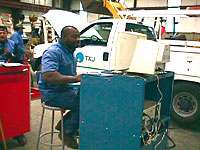February 2003
Developing an effective maintenance program
By: Ronald G. Bredemeyer, Bredemeyer & Associates, LLC
1102-A Petroleum Drive, Abilene, Texas 79602
Tel: 915-695-8809
Fax: 915-695-8974
Email Mr. Bredemeyer
View
Profile on
Experts.com.
Have you ever stopped to consider that maintenance is war? Your enemies are breakdown and
deterioration; your soldiers are the maintenance supervisors and technicians; and the people you
are protecting are the workers and customers of your organization.
As maintenance leaders, we have many strategies and weapons at our disposal � some new, some old,
some complex, and some simple. Some are more effective than others, and some work in one area of
operations and not in another. Each strategy to consider works only with the support of the correct
weapons and logistics. Your maintenance supervisors and technicians are only as good as the support
they receive from other areas of operations. Maintenance logistical support includes people, parts,
systems, space, tools, good advice, company backing, training resources, access to equipment, access
to information, and time.
You can build a powerful maintenance department by capitalizing on your strengths and working on
your weaknesses. You can get substantive and permanent improvements by building on what is there
and giving your maintenance department the same support that you give other departments.
The cost of operating a fleet of motor vehicles continues to increase almost daily. Vehicles, parts,
and fuel are not likely to decrease in price in the foreseeable future. Qualified technicians are
becoming more scarce. Government regulations are becoming more stringent and more expensive. Fleet
management must make every effort to reduce the costs if your company is to survive. The number of
vehicles in the fleet must be minimized, the cost per mile of operating these vehicles must be
minimized, and the number of miles driven must be minimized. Of course all these cost savings must
be accomplished without affecting the basic mission of the fleet or reducing service to the customer base.
We have an option in maintenance everyday. We can either try to control what happens in our fleets �
proactive � or we can just let things happen and make repairs after things break (if it ain't broke,
don't fix it) � reactive. The advantages of proactive management and better planning are greater vehicle
reliability and safety, longer vehicle life, lower operating and maintenance costs, less user downtime
and inconvenience, more effective service to customers, and increased residual value of equipment.
Reactive maintenance does not work well in today's competitive environment and is not the most effective
major strategy. In order to enjoy these benefits, we must know our costs and be proactive about
controlling them. We must identify our strengths and weaknesses.
Some costs of fleet operation are difficult to change and some costs are relatively easy to change.
Some can be changed overnight and some take much longer.
-
Preventive maintenance
A good preventive maintenance program can save you three hours of repair time for every
hour you spend on prevention. The goal of preventive maintenance, ideally, is to eliminate any
and all failures between inspections. It is simply a series of regular inspections and
vehicle services developed to detect problems in their early stages before major failures
occur. That will lower your costs, and possibly be the single most important item of cost
savings in your company .It is often done, but not correctly. Preventive maintenance
inspections must be done thoroughly and in great detail.
-
Parts purchasing
Parts purchasing can be a source of significant savings. Most maintenance personnel are
not familiar enough with the parts pricing structures to know that they can often negotiate
for better buying prices. Start by concentrating on the big, high-volume items such as brake
shoes, seals, batteries, alternators, starters, and lights. You can negotiate better
prices by consolidation and/or bulk purchases, or sometimes by just bidding. If you're not
bidding and price checking, you're wasting money.
Standardize the brands of after-market parts and specify the very best quality for your
operation. Do not accept poorer, cheaper substitutes with no warranty or those that may
cause a breakdown in the middle of a service call.
-
Tires
Tires are the largest single expense in most maintenance operations. Once again you must try
to standardize and select the very best quality tire for your application. Not all tires
work equally well in all operations. You must find, by keeping good records, which tires work
best in your specific conditions. Negotiate the very best deal. Usually you can go direct to
the manufacturer.
Since tires are such a large investment, a good tire maintenance program is absolutely
essential if this expense is to be controlled and minimized. Proper pressure maintenance,
tire balance, good alignment, and good repair are key elements. All of these items will more
than pay for themselves.
-
Productivity
Productivity of highly skilled maintenance workers and technicians is essential to cost
control. Scheduling and utilization of trained shop personnel is basic. With the shortage of
trained technicians today, it is absolutely essential that they be as productive as possible
when on the job. Do some time and motion studies to find out.
What are your technicians doing when on the clock? How much time is wasted waiting on parts?
Are they troubleshooting properly or are they merely changing parts in hopes of finding the
problem? Are they finishing repair jobs properly, and in a reasonable amount of time? Are they
getting the training they need? There are standards available by which you can measure their
performance.
Are your supervisors using the skills of each particular technician to the maximum extent
possible? If a technician is extremely good on transmissions, ensure that he gets the
transmission jobs. Use a really sharp mechanic on the preventive maintenance inspections
because he will spot more problems and fix them before they become major repairs. The
preventive maintenance inspection may be the most important job in the shop when you consider
the savings of possible downtime and customer delays.
-
Standardize
A significant reduction in parts inventory can be obtained by standardization. Training needs
are minimized by standardization. New employees can learn the equipment configuration much
quicker. Warranty recovery will be greater with standardization. Manufacturers are more inclined
to give you policy adjustments outside the normal warranty if they know that you are buying
their components regularly. Time is saved on road breakdowns when all equipment is specified the
same. Purchase prices for new equipment can be reduced, because suppliers are more inclined to
give you bigger discounts if they know they have a reasonably good assurance of your business
each year.
Vehicle replacement strategies and specifications can have a significant effect on your
maintenance and fuel costs. Consult your maintenance guys before you buy. Find out what is
working and what isn't.
-
Benchmarking
Benchmark your costs with comparable operations. This gives you a measuring stick and a standard
to work from. If you monitor your costs in detail every month, you will be able to see and
improve on your weak points.
-
Computerize
Computerization of maintenance shop functions can save dollars in the long term. Inventory
reduction, cost tracking, labor standard comparisons, reliability rankings, preventive maintenance
tracking, tire life tracking, individual component tracking (so you know what to specify next
time you buy), productivity improvements, and better scheduling are only a few of the many
benefits of proper computer utilization in shop operations. Good records usually lead to good
results in maintenance. Computers can improve your records and produce the data needed to
evaluate your costs and components properly.
-
Warranties
Develop an effective warranty recovery program. Someone must track failures and know the
applicable warranties. Millions are wasted every year because you get in a hurry to fix
something and never investigate if the part is under warranty. Don't let the so-called
manufacturer experts tell you a part is out of warranty because you never adjusted this
or that. Understand the warranty. Many individual components on the vehicle have warranties
beyond what the manufacturer gives. For example: LED lights are 10-year free replacement.
And don't overlook the warranty on replacement and remanufactured parts. Always get some
type of warranty on these items. If they are not willing to give you a warranty on their
work or part, don't buy it.
-
Fuel
Fuel is one of the largest expenses next to tires and labor. Don't overlook the possibilities
for purchasing of fuel and conserving it. Again, consolidation may help on price. Frequent
tune-ups and careful preventive maintenance inspections also help to keep the fuel mileage
where it is supposed to be. Vehicle performance directly affects fleet energy efficiency.
Maintenance keys
Give your equipment some attention! Don't assume that someone else will do it. Quality first,
standardization, accountability, training, and good records are the real keys to successful
maintenance operations. Take care of these key factors and you will be amazed at what can be achieved.
Ronald G. Bredemeyer is a consultant with Bredemeyer & Associates, LLC.
Photos courtesy of TXU Gas and Electric.
Reprinted from Gas Utility Manager Magazine
See his Profile on Experts.com.
©Copyright 2003 - All Rights Reserved
DO NOT REPRODUCE WITHOUT WRITTEN PERMISSION BY AUTHOR.










